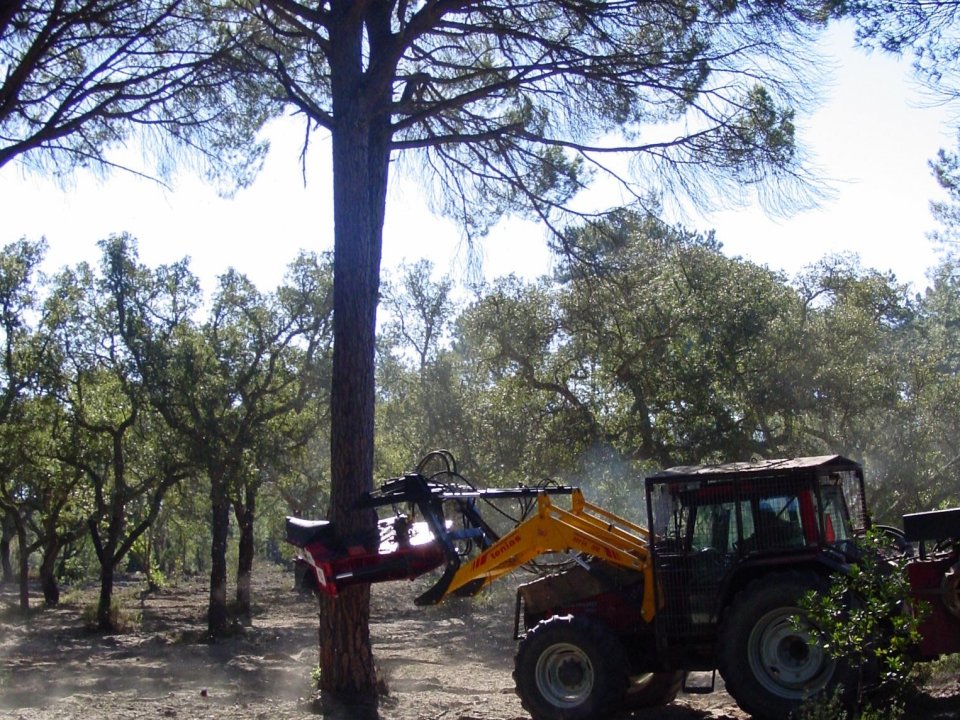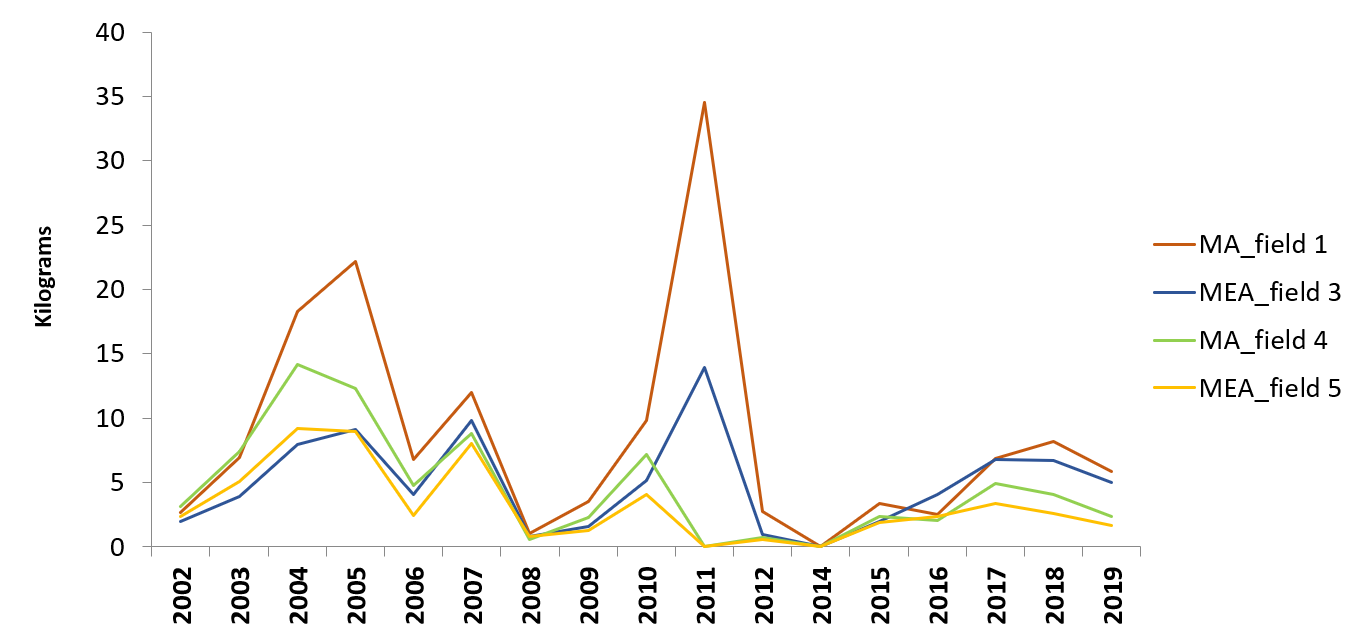
This factsheet aims to present the mechanical harvesting option and the productivity monitorization done in umbrella pine stands harvested in both ways (manual and mechanically) in the last 17 years, located in Chamusca, Portugal. 5,000 m2 sample plot were installed in stand planted in the 1960s.
Pine nuts have been consumed since the Palaeolithic. Manual harvesting techniques have evolved little since, from collecting pine nuts shed from the open cones on the tree to climbing for picking the cones.
In the 1980s, cone harvesting machines vibrating the stem to cause the cones to fall had been developed in Italy and arrived in Portugal in the late 1990s. Yet few pine forests are mechanically harvested in Portugal, due to:
• Available labor for manual harvest, in spite of the high risk;
• Reduced number of service providers with harvesting machines;
• Conformation of stone pines poorly suited for mechanized harvesting;
• Fear of potential damage to the tree and the cone production in the following years.
Mechanical harvesting promotes the cleaning of pine trees, by the fall of dry branches and needles, and also of pine cones affected by pest drilling. In Spain, in the Valladollid area, areas with mechanized harvesting presented higher attacks of Tomicus piniperda when compared to those of manual harvesting.
According to Gonçalves (2016) comparing the two harvesting methods, mechanized harvesting has an average efficiency of detaching pine cones above 86%. And it is 6 to 15 times faster than manual harvesting, with negligible damage to trees. The average harvesting cost was reduced, offsetting the amount of pine cone that remains on the tree.
The 17 years comparison between plots harvested manually and mechanically showed no differences in terms of pine cone production.
- Track the weighings of the pine cone produced on your farm.
- Hire specialized / experienced operators;
- Ensure that the harvest takes place in safe conditions, avoiding rainy or windy days, which increase the labour risks of accidents;
- The intensity of vibration applied to each tree can be different (5 to 8s) but only enough to make the mature pine cone fall;
- Do not harvest mechanically while the canopy is wet, or early in the morning on frost days;
- The use of mechanized harvesting should not occur when the vegetative activity of the tree beguns and the immature pine cone may fall due to the greater fragility of the tissues;
- Monitor the presence of scoliths (xylophagous insects) in areas with mechanized harvesting, checking the existence of bark that stands out and with galleries on the pine wood.
Mechanical harvesting decreases the time and cost spent with pine cone collection, the robbery risks, a common problem, and improves health and safety. Is an alternative to manual harvesting and it will increase in the future due to the lack of skilled workers that is already occurring to perform this operation. The main disadvantage is the maintenace of a residual amount of pine cones not detached, but is largely compensated by the cost-efficiency of the overall operation.
When poorly performed (out of season or with an inappropriate intensity), mechanical harvesting has a risk of detaching the pine cones for the next years and wound the tree in the place where the vibratory jaws embrace the trunk.
The greater use of this technology in the future needs a different approach to the stone pine plantations, namelly in terms of stand density, thinnings and tree prunning, to maximize the vibration effect to detach the pine cones. Older trees with very large crowns, or trees with short trunks that ramify at a lower height are inadequate for mechanical harvesting.
Also training sessions are needed to assure skilled operators to work the machinery.
Conceição Santos Silva, mcsilva@unac.pt , http://www.unac.pt/
Further information
UNAC, 2014 - Guia de colheita e comercialização da pinha. Lisboa http://www.unac.pt/index.php/documentos/publicacoes/46-guia-de-colheita-e-comercializacao-de-pinha/file
Gonçalves, A.C., 2006 - Colheita mecânica da pinha e influência da estrutura do povoamento. Acção 8.1.Desenvolvimento experimental e demonstração do Programa AGRO. Universidade de Évora.
Gonçalves, A.C.,Dias, A.B., Afonso, A., Pereira, D.G., Pinheiro, A., Peça, J.O., 2016 – Mechanical versus manual harvesting of Pinus pinea cones. Biosystems engineering 143, 50-60.
Martínez-Zurimendi, P., Álvarez, J. M., Pando, V., Domínguez, M., Gordo, J., Finat, L., & Sierra-de-Grado, R. (2009). Efectos del vibrado del pino piñonero (Pinus pinea L .) en el vigor de los árboles : densidad de copa , crecimiento de guías y parásitos de debilidad. Investigación Agraria: Sistemas y Recursos Forestales, 18(1), 50–63.
Knight, T.A., 1806. On the direction of the radicle and germen during the vegetation of seeds. Philosophical Transactions of the Royal Society of London 99, 108–120.
Conceição Santos Silva

Average anual production (pine cones weight/ tree) between 2002 and 2019 in areas manual harvested (MA) and mechanical harvested (MEA). APFC, 2019.
